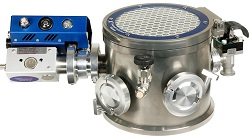A VITAL step in sample preparation before analysis by electron microscopy is the cleaning stage, in which all contaminants must be removed from objects under study. One common problem encountered at this stage is that the cleaning process can damage the surface of the specimen, reducing the value and usefulness of the images generated.

Evactron SoftClean system from XEI uses RF plasma to break down hydrocarbons for electron microscope sample prep
At Nanolab Technologies, a California-based specialist in failure analysis, advanced microscopy, and focused ion beam (FIB) circuit editing, the recent addition of an Evactron SoftClean specimen cleaning chamber from XEI Scientific is reported to be helping the company find new ways of improving its services.
The Evactron SoftClean combination is a downstream chemical etching system, giving a more gentle clean than the more common plasma cleaning systems used in tunnelling electron microscope (TEM and scanning tunnelling electron microscope (STEM) operations.
Samples are cleaned by a radio-frequency (RF) plasma process that breaks hydrocarbons into carbon dioxide, carbon monoxide, and water. According to XEI, this process can prevent the specimen damage caused by heat and ion bombardment that is typically associated with sputtering of energetic ions. This more delicate approach chemically ‘ashes’ hydrocarbons and pumps them free of the chamber.
Jein Shyue, VP of technology development at Nanolab Technologies, notes: “we are now able to control contamination without etching or damaging our samples, in particular those with polymer fillers.”
